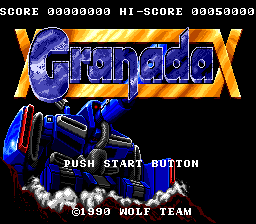Difference between revisions of "Granada"
From Sega Retro
| Line 7: | Line 7: | ||
| romsize=512KB | | romsize=512KB | ||
| usa=1990 | | usa=1990 | ||
| − | | japan=1990 | + | | japan=16 November 1990 |
| + | | rrp_jp=6,800 | ||
| genre=Shoot-'em-Up | | genre=Shoot-'em-Up | ||
}} | }} | ||
| − | '''''Granada''''' is a 1990 shoot-'em-up by [[Wolf Team]] released in the US and Japan for the [[Sega Mega Drive]]. "Granada" is a mobile tank-like weapon whose origin is uncertain. In September 2016, Leon Todo, a private mercenary, accepts a task from an enterprise agent that takes him to Japan, where he finds Granada and uses it to complete said task. | + | '''''Granada''''' (グラナダ) is a 1990 shoot-'em-up by [[Wolf Team]] released in the US and Japan for the [[Sega Mega Drive]]. "Granada" is a mobile tank-like weapon whose origin is uncertain. In September 2016, Leon Todo, a private mercenary, accepts a task from an enterprise agent that takes him to Japan, where he finds Granada and uses it to complete said task. |
You are situated in a large field full of enemies, obstacles, and enemy generators that you may freely move around (unlike most conventional shoot-'em-ups). The goal of each level is to destroy each enemy generator (red dots on the HUD in the bottom right corner) and then a boss all before the timer runs out. {{A}} shoots a normal weapon (which you can rapidfire) and {{C}} shoots a missile (which you can only shoot one of at a time, though you have unlimited missiles, and will knock you back a bit). Holding {{B}} locks your orientation so moving the D-pad will not also rotate your ship. You can also find a miniature ship that will help you in its own ways. | You are situated in a large field full of enemies, obstacles, and enemy generators that you may freely move around (unlike most conventional shoot-'em-ups). The goal of each level is to destroy each enemy generator (red dots on the HUD in the bottom right corner) and then a boss all before the timer runs out. {{A}} shoots a normal weapon (which you can rapidfire) and {{C}} shoots a missile (which you can only shoot one of at a time, though you have unlimited missiles, and will knock you back a bit). Holding {{B}} locks your orientation so moving the D-pad will not also rotate your ship. You can also find a miniature ship that will help you in its own ways. | ||
| + | |||
| + | ==Credits== | ||
| + | * '''Game Design & Program''': Toshio Toyota | ||
| + | * '''Graphics''': Masayuki Matsushima | ||
| + | * '''Graphics''': Kazuhiro Nagata | ||
| + | * '''Graphics''': Mutunori Sato | ||
| + | * '''Music''': Ryota Furuya | ||
| + | * '''Music''': Motoi Sakuraba | ||
| + | * '''Music''': Masaaki Uno | ||
| + | * '''Producer''': Masahiro Akashino | ||
==Physical Scans== | ==Physical Scans== | ||
Revision as of 17:27, 7 November 2010
This short article is in need of work. You can help Sega Retro by adding to it.
| Granada |
|---|
| System(s): Sega Mega Drive |
| Publisher: Wolf Team (US Renovation) |
| Developer: Wolf Team |
| Genre: Shoot-'em-Up |
Granada (グラナダ) is a 1990 shoot-'em-up by Wolf Team released in the US and Japan for the Sega Mega Drive. "Granada" is a mobile tank-like weapon whose origin is uncertain. In September 2016, Leon Todo, a private mercenary, accepts a task from an enterprise agent that takes him to Japan, where he finds Granada and uses it to complete said task.
You are situated in a large field full of enemies, obstacles, and enemy generators that you may freely move around (unlike most conventional shoot-'em-ups). The goal of each level is to destroy each enemy generator (red dots on the HUD in the bottom right corner) and then a boss all before the timer runs out. ![]() shoots a normal weapon (which you can rapidfire) and
shoots a normal weapon (which you can rapidfire) and ![]() shoots a missile (which you can only shoot one of at a time, though you have unlimited missiles, and will knock you back a bit). Holding
shoots a missile (which you can only shoot one of at a time, though you have unlimited missiles, and will knock you back a bit). Holding ![]() locks your orientation so moving the D-pad will not also rotate your ship. You can also find a miniature ship that will help you in its own ways.
locks your orientation so moving the D-pad will not also rotate your ship. You can also find a miniature ship that will help you in its own ways.
Credits
- Game Design & Program: Toshio Toyota
- Graphics: Masayuki Matsushima
- Graphics: Kazuhiro Nagata
- Graphics: Mutunori Sato
- Music: Ryota Furuya
- Music: Motoi Sakuraba
- Music: Masaaki Uno
- Producer: Masahiro Akashino


